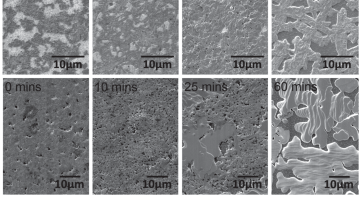General Amalgamation Theory
Abstract
This talk will be on general amalgamation theory, covering ground from the 1950s to original research, with applications and examples from many different areas of mathematics and ranging from classical results to open problems.
Quantum character varieties and the double affine Hecke algebra
Abstract
The character variety of a manifold is a moduli space of representations of its fundamental group into some fixed gauge group. In this talk I will outline the construction of a fully extended topological field theory in dimension 4, which gives a uniform functorial quantization of the character varieties of low-dimensional manifolds, when the gauge group is reductive algebraic (e.g. $GL_N$).
I'll focus on important examples in representation theory arising from the construction, in genus 1: spherical double affine Hecke algebras (DAHA), difference-operator q-deformations of the Grothendieck-Springer sheaf, and the construction of irreducible DAHA modules mimicking techniques in classical geometric representation theory. The general constructions are joint with David Ben-Zvi, Adrien Brochier, and Noah Snyder, and applications to representation theory of DAHA are joint with Martina Balagovic and Monica Vazirani.
16:00
Wach modules, regulator maps, and ε-isomorphisms in families
Abstract
In this talk on joint work with REBECCA BELLOVIN we discuss the “local ε-isomorphism” conjecture of Fukaya and Kato for (crystalline) families of G_{Q_p}-representations. This can be regarded as a local analogue of the global Iwasawa main conjecture for families, extending earlier work of Kato for rank one modules, of Benois and Berger for crystalline representations with respect to the cyclotomic extension as well as of Loeffler, Venjakob and Zerbes for crystalline representations with respect to abelian p-adic Lie extensions of Q_p. Nakamura has shown Kato’s - conjecture for (ϕ,\Gamma)-modules over the Robba ring, which means in particular only after inverting p, for rank one and trianguline families. The main ingredient of (the integrality part of) the proof consists of the construction of families of Wach modules generalizing work of Wach and Berger and following Kisin’s approach via a corresponding moduli space.
Organometal halide perovskite (OMHP) is hardly a household name, but this new material is the source of much interest, not least for Oxford Applied Mathematicians Victor Burlakov and Alain Goriely as they model the fabrication and operation of solar cells.
The Loop Theorem of Papakyriakopoulos
Abstract
The study of 3-manifolds is founded on the strong connection between algebra and topology in dimension three. In particular, the sine qua non of much of the theory is the Loop Theorem, stating that for any embedding of a surface into a 3-manifold, a failure to be injective on the fundamental group is realised by some genuine embedding of a disc. I will discuss this theorem and give a proof of it.
Regenerative Medicine from an Engineer's Perspective
Abstract
Regenerative medicine offers great hope in curing many currently untreatable diseases. Tissue engineering and stem cell therapy are the two main components of regenerative medicine. In this talk, I will discuss how engineering can make contributions to this highly interdisciplinary field, including biomaterials as 3D scaffolds, bioreactor design, and stem cell bioprocessing.
15:00
Hash Proof Systems over Lattices Revisited
Abstract
Hash Proof Systems or Smooth Projective Hash Functions (SPHFs) are a
form of implicit arguments introduced by Cramer and Shoup at
Eurocrypt’02. They have found many applications since then, in
particular for authenticated key exchange or honest-verifier
zero-knowledge proofs. While they are relatively well understood in
group settings, they seem painful to construct directly in the lattice
setting.
Only one construction of an SPHF over lattices has been proposed, by
Katz and Vaikuntanathan at Asiacrypt’09. But this construction has an
important drawback: it only works for an ad-hoc language of ciphertexts.
Concretely, the corresponding decryption procedure needs to be tweaked,
now requiring q many trapdoor inversion attempts, where q is the modulus
of the underlying Learning With Error (LWE) problem.
Using harmonic analysis, we explain the source of this limitation, and
propose a way around it. We show how to construct SPHFs for standard
languages of LWE ciphertexts, and explicit our construction over a
tag-CCA2 encryption scheme à la Micciancio-Peikert (Eurocrypt’12).
If there is enough time, we will conclude with applications of these
SPHFs to password-authenticated key exchange, honest-verifier
zero-knowledge and a variant of witness encryption.


